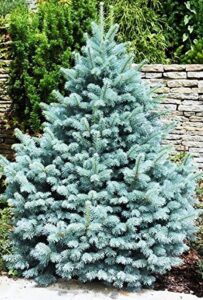by Ken Lain, the mountain gardener

Blue Spruce (Picea pungens) is a trendy evergreen conifer tree with a handsome, naturally pyramidal form with rigid tiered branches covered with stiff gray-blue needles. Spruce trees make a perfect evergreen windbreak or tall screening tree and can be used as a specimen plant in larger landscapes. Colorado Blue Spruce Trees are known for their striking blue needles and are an excellent choice for living Christmas trees. Fat Albert is a hardy evergreen tree of more compact size, making it ideal for smaller gardens and container plantings.
Watering Needs: Needs regular watering – weekly, or more often in extreme heat.
Botanical Pronunciation: Picea pungens (PY-see-a PUN-jenz)
Plant type: Conifer, Tree
Deciduous/evergreen: Evergreen
USDA climate zones: 1 – 10
Growth habit: Pyramidal
Growth rate: 18″ per year
Average landscape size: Reaches 10-12 ft. tall in a few years; 40′ ft. tall x 12′ ft. wide at maturity.
Special features: Bird Friendly, Dramatic Foliage Color, Easy Care, North American Native Selection, Tolerates Road Salt, Year-round Interest.
Foliage color: Dark Green to Blue
Blooms: Prized for foliage and small cones.
Design Ideas: Twice taller than it is wide, this native forest evergreen is best used on large properties. Use it to separate tall multistory buildings or in shelterbelts and windbreaks. Tall enough to screen the view from second- or third-story windows. Gorgeous in estate-sized forests of broadleaf and conifers, it stands out against deciduous trees and snow blankets.
Companion Plants: Spirea; Butterfly Bush; Weigela; Blanket Flower, Gaillardia; Stonecrop, Sedum
PLANTING A BLUE SPRUCE
Choosing a site for this tree should allow for its mature height of at least 40+’ feet tall and 10’+ feet wide. The canopy tends to grow in a narrow upright shape. Never plant trees deeper than planted initially in the pot. Doing so can cause rotting of the stem and death to the tree.
1. Dig a hole 2-3 times the width of the container but the same depth.
2. Check drainage by filling the hole with water. All water should drain away within 12 hours. If not, you have hardpan, and it will need to be penetrated – dig deeper & add a layer of gypsum.
3. Watters “Mulch” – Blend 1 part mulch with two parts soil taken from hole.
4. Score the root ball sides and bottom with a utility knife or pruners.
5. Blend Soil – Mulch – 7-4-4 Plant Food & Aqua Boost mixture, then pack firmly around the rootball.
6. Stakes & V-Strap – install stakes just outside the roots making sure the stakes are deeper than soil mix. Remove the original shipping stake. Use V-Straps around the trunk of the tree to support against the wind. Use one strap just under the tree canopy and a second 18″ below the first.
7. Build a well around the tree and water with “Root & Grow” mixture.
Water with Root & Grow every 2 weeks for the first 2 months.
Soil and Sun
This Spruce grows in virtually any mountain soil conditions, including alkaline or clay soils. Ideally, it should have slightly acidic, well-drained soil. Still, its tolerant nature means it may be planted in difficult areas where other trees are hard to grow.
6+ Hours of the sun are needed during the growing season for the best spring growth and blue Autumn hues.
Water newly planted trees regularly with a garden hose for at least one month (2 months in Summer). Automatic irrigation systems may not be sufficient initially. Water frequency will vary according to the season, exposure, and plant size.
April – Oct this Spruce should be irrigated 2 x weekly.
Nov – Mar this Spruce should be irrigated 2 x monthly.
Feed 4x Times per Year with either 7-4-4 All Purpose Plant Food, Soil Sulfur, or Humic. Here’s the recommendation by season:
Spring = 7-4-4 All Purpose Food + Soil Sulfur
Summer = 7-4-4 All Purpose Food + Humic
September = 7-4-4 All Purpose Food
December = 7-4-4 All Purpose Food

